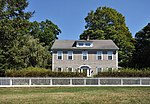Lake Lillinonah
AC with 0 elementsConnecticut geography stubsLakes of Fairfield County, ConnecticutLakes of Litchfield County, ConnecticutReservoirs in Connecticut ... and 1 more
Tourist attractions in Fairfield County, Connecticut

Lake Lillinonah is a manmade lake located in Fairfield, Litchfield and New Haven counties of Western Connecticut, approximately 60 miles (97 km) northeast of New York City. It is the second largest lake in Connecticut, smaller only than Candlewood Lake. The lake is bordered by six towns: Brookfield, Bridgewater, Newtown, New Milford, Roxbury, and Southbury. It was formed in 1955 by impoundment of the Housatonic River and the Shepaug River by the Shepaug Dam which was built by the Connecticut Light and Power Company. Some of the most expensive real estate in the Greater Danbury area is located on the shores of the lake, in the towns of Brookfield, Bridgewater and Newtown.
Excerpt from the Wikipedia article Lake Lillinonah (License: CC BY-SA 3.0, Authors, Images).Lake Lillinonah
Kuhne Road,
Geographical coordinates (GPS) Address Nearby Places Show on map
Geographical coordinates (GPS)
| Latitude | Longitude |
|---|---|
| N 41.469 ° | E -73.312 ° |
Address
Kuhne Road 214
06488
Connecticut, United States
Open on Google Maps







